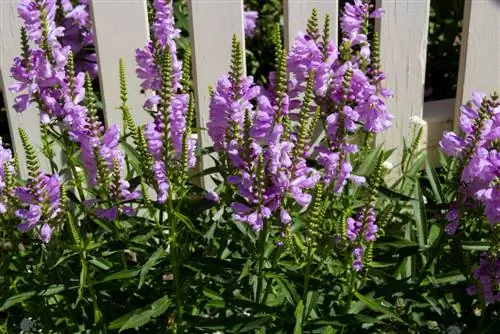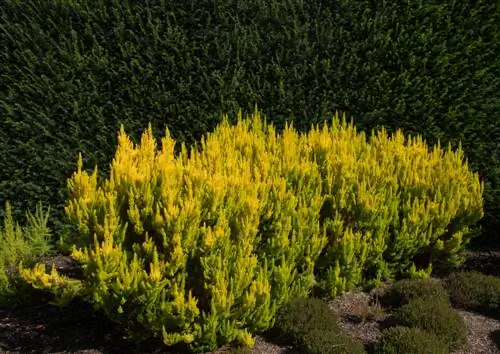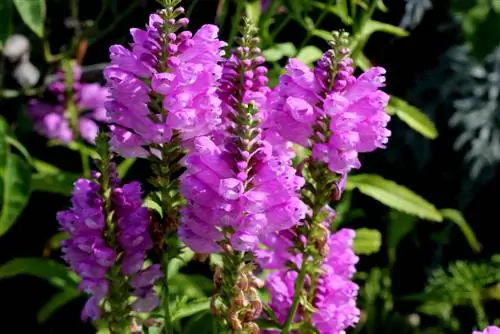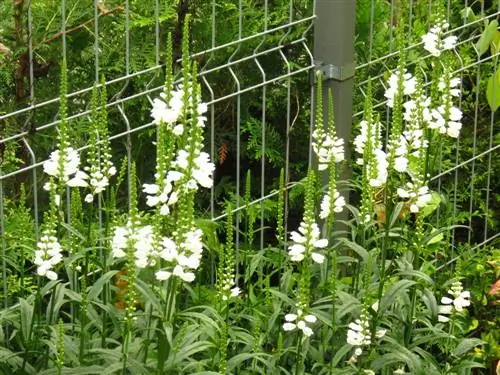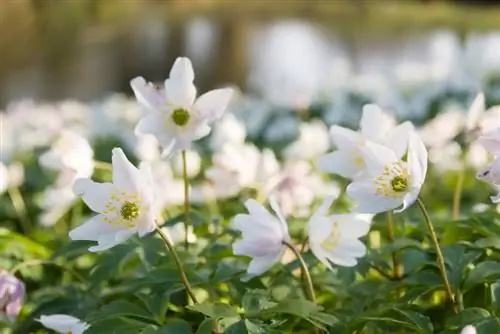- Author admin [email protected].
- Public 2023-12-25 17:45.
- Last modified 2025-01-23 11:19.
Joint flowers have conquered many gardens as rich-flowering perennials. They are robust and easy to spread. Proper care is therefore of great importance so that the magnificent perennial retains its attractiveness for many years. It is an enrichment not only for the human eye.
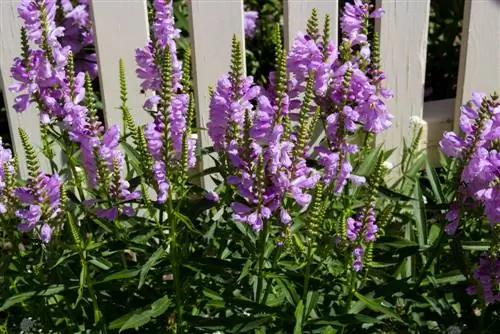
What is a joint flower and what conditions does it prefer?
The joint flower (Physostegia virginiana) is a perennial with colorful, tubular flowers in white, pink or purple that appear between July and September. It prefers sunny to partially shaded locations and moist, well-drained soil. The plant is frost hardy and is suitable for perennial borders, natural gardens or as a container plant.
Origin
The species Physostegia virginiana, which is one of the labial family, is hidden behind the joint flower. It is the only plant within the genus of the same name with ornamental value. Their original distribution area extends across eastern North America. Here the plant grows on river banks, in damp meadows and in bushes. There are numerous varieties that differ in shape, color and size.
Growth
Joint flowers grow as perennial herbaceous plants. They develop an underground rhizome from which shoots between 30 and 150 centimeters high grow. The root tuber forms runners with which the plant expands over large areas. It does not occur across the board, but rather develops isolated clumps. Their above-ground shoots are square. Articulated flowers reach growth widths of between 60 and 90 centimeters.
leaves
Physostegia virginiana develops stem leaves that are opposite each other in pairs. The leaf pairs of two nodes lying one above the other are crossed relative to one another. The leaves are elongated and appear lanceolate. They are dark green in color and reach a length of up to 12.5 centimeters. The edge of the leaf is serrated to toothed.
Bloom
The terminal flowers appear between July and September and are densely packed together in long spikes. Articular flowers develop tubular lip flowers that can change their orientation. It seems as if they are connected to the shoot by a joint. This property gave the plant its German name. The color palette of the flowers ranges from white to wine red to pink and purple.
Usage
Articulated flowers are suitable for group planting in flower beds and perennial borders. With its picturesque growth, the flowering plant enriches damp areas in water gardens. In the natural garden, the nectar and pollen plants provide a valuable source of food for butterflies and bumblebees. The plant beautifies terraces and balconies or potted gardens in pots. The inflorescences can be cut off and used for bouquets.
Ideal planting partners:
- Raublatt-Aster
- Indian nettle
- Lavender
- Widow Flower
- Pennisetum grass
Is joint flower poisonous?
There are no indications of toxic ingredients. You can safely plant the mint plant in gardens where there are children or pets.read more
Which location is suitable?
The articular flower prefers a place protected from the wind. It grows in sunny to partially shaded locations. When there is a lack of light, the perennial develops thin stems and flower development is restricted. Choose the location carefully, because the plants' ability to spread can quickly become a burden in unfavorable places.read more
What soil does the plant need?
Physostegia virginiana grows in well-drained soil that is moderately nutrient-rich. On soils that are rich in humus, the shoots shoot up. They are not very stable and need support. Lean heavy soils before planting by mixing in sand. Fresh to moist conditions provide the articular flower with optimal growth conditions. The pH value can range from slightly acidic to slightly alkaline.
Propagate joint flower
Articular flowers are divided every two years and dense stands are thinned out in this way. Division takes place in autumn after the flowering period. Use a digging fork to prick the root ball and lift it out of the ground. The roots should not be injured so that the partial plants can grow well after the measure.
Separate the rhizome in the young growth area into several pieces. Each root part should have a pronounced fine root system and several leaves. Cut unclean cuts and remove injured parts of the plant. Place the partial plants immediately in the prepared planting holes and water the substrate thoroughly.
Sowing
The seeds of the joint flowers are cold germinators that are sown in early spring. For optimal germination, lower temperatures between five and ten degrees Celsius are optimal.
You can distribute the seeds directly in the bed or sprinkle them in a freezer bag with a little moist sand. The bag is stored in the refrigerator for two to four weeks. In the freezer or freezer, the cold shock destroys the seeds. After stratification, the seeds are sown on nutrient-poor growing substrate or in a bed. Keep the soil evenly moist.
Cuttings
Joint flowers can be propagated via head cuttings. Cut off shoots 10 to 15 centimeters long just below a node. Remove the lowest leaves and put the shoots in potting soil. The cuttings need high humidity to form roots. You can put a plastic film over the container or wet the substrate and the shoots with water every day. As soon as the shoots have developed new leaves, they can be repotted.
The correct planting distance
Place between eight and eleven plants per square meter. Joint flowers develop optimally at a distance of 30 centimeters from the next plant. To prevent the spread, you should work a rhizome barrier into the soil when planting. Joint flowers can be planted from spring to autumn.
Articulated flower in pot
The flowering perennial is suitable for beautifying large plant pots. Choose the pot size according to the size of the root ball. The pot should offer enough space so that the unrooted substrate can store excess water. Drainage holes and drainage are essential to prevent waterlogging of the substrate. If you use rustic clay pots without holes in the bottom, you should only spray the substrate with water and not use a watering can. This way you can better control the amount of watering.
Balcony
In the pot, the joint flower beautifies sunny areas on the balcony. It also thrives on west or east facing balconies. The mint plant reacts to shady locations with reduced flower development. Make sure to moisten the substrate regularly. The substrate dries out more quickly on airy and sunlit balconies.
Watering the joint flower
Physostegia virginiana requires regular watering during the summer months to prevent the root ball from drying out. Water the plant consistently during long dry periods. Regular mulching has proven to be a useful maintenance measure. The layer protects the substrate from excessive evaporation. Thanks to its good water storage capacity, a mulch cover prevents waterlogging from forming.
Fertilize the joint flower properly
Before the plants begin their growth phase, they are provided with fresh compost in spring. This ensures a long-term supply of nutrients, so that you no longer have to fertilize additionally in the same year.
Cut the joint flower correctly
So that joint flowers remain attractive for many years and do not spread uncontrollably in the garden, regular pruning is necessary.
Pruning after flowering
When the flowers have completely withered, joint flowers are cut back. Cut off the spent ears down to the top pair of leaves. This promotes the formation of new shoots and prevents self-propagation via scattered seeds. The stock is better ventilated so that diseases are prevented. Flowered inflorescences can be removed at any time. This measure ensures that the plant remains permanently attractive.
Autumn cut
In late autumn, joint flowers are radically cut back. Cut stems close to the ground and remove diseased plant parts. This measure increases the vitality of the plant and prevents withered leaves from rotting between crops.
Rhizome division
You can limit wild growth by cutting back dense stands after a few years and dividing them after digging them up. Place the young rhizome pieces in their original location. This will rejuvenate the plant and promote flower development.
hardy
Joint flowers prove to be frost hardy. In harsh locations or during snow-free winter months, additional winter protection is required. Cover the bottom with pine branches or brushwood. When layering, make sure the branches are close together. Spruce twigs have proven to be effective. The branches shed their needles in spring so that the plants get more light again.
When the mint family grows under evergreen trees such as rhododendrons, conifers or cherry laurel, the foliage serves as a natural protection from the cold. Joint flowers are also better protected in winter when they grow directly on the south wall of a house.
How to protect potted plants:
- Place the pot on an insulating surface
- Wrap the tub with several layers of fabric
- Moisten the substrate on frost-free days
Fungal infestation
Suboptimal site conditions lead to fungal spores settling on the plants. Weakened plants whose vitality has been disturbed by incorrect care measures are often affected.
Downy mildew
If the stands become too dense, a humid microclimate develops. Downy mildew can spread under these conditions. Make sure there is enough distance when planting. Plant tonics have a preventive effect. If there is an infestation, the affected plant parts should be generously removed. Fungicides should only be used in late stages.
Gray horse
In humid conditions, shoot tips, buds, stems and leaves tend to rot. They become soft and provide a perfect breeding ground for gray mold spores. The fungus prefers to spread on plants that are too densely planted. A low permeability in the substrate promotes the spread of gray mold. When watering, be careful not to get the leaves too wet. Rock dust and horsetail decoction have proven to be effective against infestations.
Tip
Articulated flowers provide colorful accents in the late summer garden. Here the labiate plants cut a fine figure between the brown-leaved waterwort 'Chocolate' and rich-flowered phlox varieties.
Varieties
- Crystal Peak White: Bright white flowers, from June to September. Reaches heights between 30 and 40 centimeters.
- Summer Snow: Firm, upright growth. Blooms pure white between August and October. Reaches heights between 70 and 80 centimeters.
- Bouquet Rose: Blooms in pink between August and October. Grows between 80 and 90 centimeters high.
- ‚Vivid: Flowers purple-pink, from September to October. Grows between 60 and 70 centimeters high.

